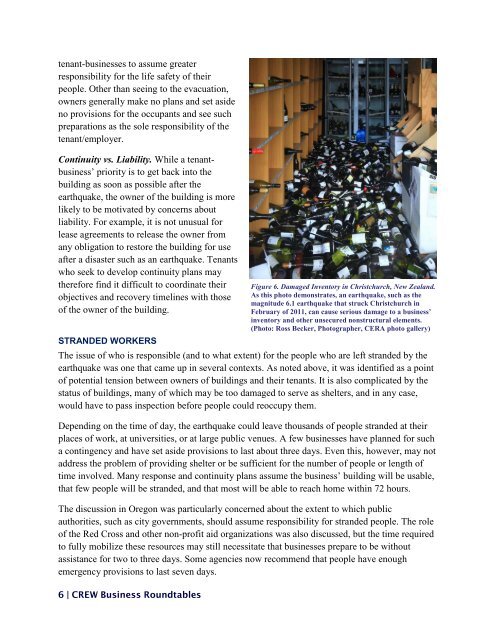Businesses in Cascadia - CREW
Businesses in Cascadia - CREW
Businesses in Cascadia - CREW
- No tags were found...
You also want an ePaper? Increase the reach of your titles
YUMPU automatically turns print PDFs into web optimized ePapers that Google loves.
tenant-bus<strong>in</strong>esses to assume greaterresponsibility for the life safety of theirpeople. Other than see<strong>in</strong>g to the evacuation,owners generally make no plans and set asideno provisions for the occupants and see suchpreparations as the sole responsibility of thetenant/employer.Cont<strong>in</strong>uity vs. Liability. While a tenantbus<strong>in</strong>ess’priority is to get back <strong>in</strong>to thebuild<strong>in</strong>g as soon as possible after theearthquake, the owner of the build<strong>in</strong>g is morelikely to be motivated by concerns aboutliability. For example, it is not unusual forlease agreements to release the owner fromany obligation to restore the build<strong>in</strong>g for useafter a disaster such as an earthquake. Tenantswho seek to develop cont<strong>in</strong>uity plans maytherefore f<strong>in</strong>d it difficult to coord<strong>in</strong>ate theirobjectives and recovery timel<strong>in</strong>es with thoseof the owner of the build<strong>in</strong>g.STRANDED WORKERSThe issue of who is responsible (and to what extent) for the people who are left stranded by theearthquake was one that came up <strong>in</strong> several contexts. As noted above, it was identified as a po<strong>in</strong>tof potential tension between owners of build<strong>in</strong>gs and their tenants. It is also complicated by thestatus of build<strong>in</strong>gs, many of which may be too damaged to serve as shelters, and <strong>in</strong> any case,would have to pass <strong>in</strong>spection before people could reoccupy them.Depend<strong>in</strong>g on the time of day, the earthquake could leave thousands of people stranded at theirplaces of work, at universities, or at large public venues. A few bus<strong>in</strong>esses have planned for sucha cont<strong>in</strong>gency and have set aside provisions to last about three days. Even this, however, may notaddress the problem of provid<strong>in</strong>g shelter or be sufficient for the number of people or length oftime <strong>in</strong>volved. Many response and cont<strong>in</strong>uity plans assume the bus<strong>in</strong>ess’ build<strong>in</strong>g will be usable,that few people will be stranded, and that most will be able to reach home with<strong>in</strong> 72 hours.The discussion <strong>in</strong> Oregon was particularly concerned about the extent to which publicauthorities, such as city governments, should assume responsibility for stranded people. The roleof the Red Cross and other non-profit aid organizations was also discussed, but the time requiredto fully mobilize these resources may still necessitate that bus<strong>in</strong>esses prepare to be withoutassistance for two to three days. Some agencies now recommend that people have enoughemergency provisions to last seven days.6 | <strong>CREW</strong> Bus<strong>in</strong>ess RoundtablesFigure 6. Damaged Inventory <strong>in</strong> Christchurch, New Zealand.As this photo demonstrates, an earthquake, such as themagnitude 6.1 earthquake that struck Christchurch <strong>in</strong>February of 2011, can cause serious damage to a bus<strong>in</strong>ess’<strong>in</strong>ventory and other unsecured nonstructural elements.(Photo: Ross Becker, Photographer, CERA photo gallery)




